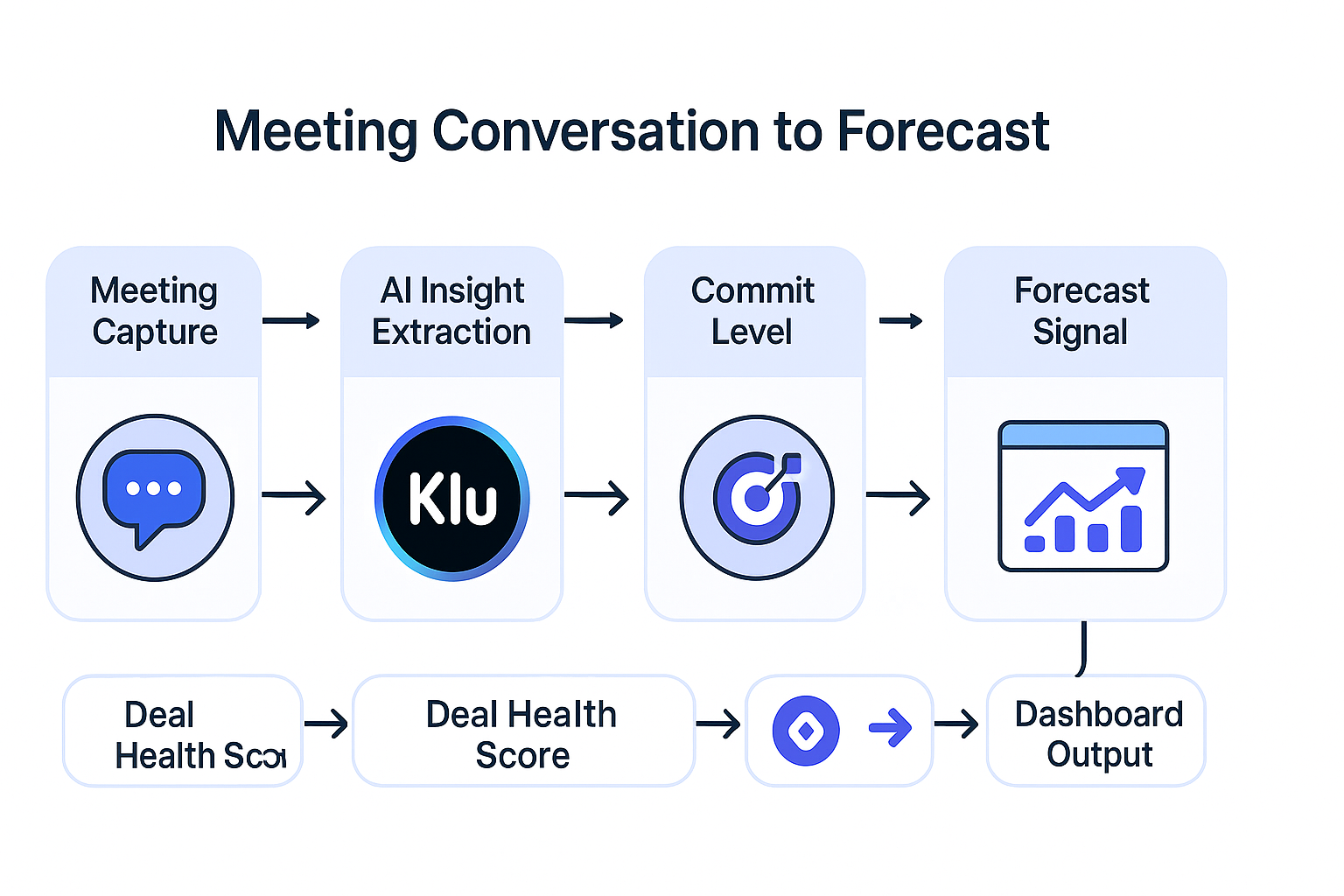 Sami AZ
Sami AZ
Sales forecasting has always been one of the most difficult parts of revenue operations. Even the best sales teams routinely struggle with missed projections, inaccurate pipeline visibility, and deal slippage that appears without warning. The core problem is simple. Traditional forecasting relies on CRM updates that are incomplete or outdated. Most of the information that should inform a forecast happens inside meetings, yet very little of that insight is ever captured or analyzed.
AI powered meeting analysis is changing this. By extracting real time signals from sales conversations, revenue teams can replace guesswork with data driven forecasting. Instead of depending on rep notes or subjective opinions, leaders gain objective insight into deal momentum, buyer intent, competitive pressure, and risk factors.
This article explains how AI improves forecast accuracy, how meeting data becomes the most reliable source of truth in a sales organization, and how Klu uses real conversations to generate accurate, dynamic forecasting that scales across teams.
Most organizations miss targets because their forecasts are built on incomplete data. CRMs represent only a fraction of what happens during the sales cycle. Reps update fields when they remember, often hours after meetings. Subjective interpretation replaces factual evidence. Important details get lost. Managers are forced to rely on instinct rather than insight.
Common causes of forecast inaccuracy include:
Meeting conversations hold the information that CRMs lack, including subtle signals like tone, hesitation, interest, uncertainty, and real time commitments. Forecasts fail when these signals remain hidden.
Meeting conversations are the richest source of truth in the pipeline. They reveal how the buyer actually feels, what motivates them, and what concerns hold them back. When AI analyzes meetings, it uncovers signals that manual processes never capture.
AI detects moments when buyers express interest, urgency, or alignment. These signals help forecast which deals are likely to advance.
Buyers frequently make commitments in meetings that never get logged. Examples include internal timelines, decision dates, budget confirmation, and stakeholder involvement.
AI uncovers risk far earlier than humans can. Signs include repeated objections, unclear value alignment, stalled conversations, or a shift in sentiment.
When buyers mention competing tools, missing features, or pricing comparisons, these are critical insights for forecast accuracy.
AI tracks how the energy of the deal changes over time. Positive momentum means the opportunity is heating up. Negative momentum means a slip is likely.
None of this information is stored in the CRM unless AI extracts it.
Forecasting is transforming in 2025. Leaders no longer trust manual data entry as the foundation of revenue predictability. AI meeting intelligence delivers continuous insights that update forecasts in near real time.
This shift removes bias from forecasting. Instead of asking reps to estimate deal probability based on gut feeling, AI analyzes actual conversations. Deal health becomes measurable rather than speculative. Signals like commitment frequency, sentiment trends, and objection patterns replace guesswork.
The biggest advantage is that forecasts become forward looking and based on real behavior rather than assumptions.
Klu is designed to make forecasting reliable by using real meeting data. Rather than waiting for CRM updates or end of quarter reviews, Klu analyzes conversations immediately after each meeting.
Here is how Klu turns raw conversations into accurate forecasts.
Klu connects to Google Meet, Microsoft Teams, and Zoom. Meetings are captured automatically without requiring reps to start or upload recordings.
Klu analyzes the entire meeting. It breaks conversations into themes, decisions, objections, questions, and buyer statements. It detects intent, risk, sentiment, and competitive mentions. This becomes the core data feeding the forecast.
AI converts meeting signals into a dynamic deal health score. This score changes naturally as new insights emerge. If a buyer expresses strong urgency, the score increases. If the buyer raises new objections, the score adjusts downward.
Klu identifies actual buyer timelines, readiness signals, and deadlines. These insights are crucial for accurate forecasts.
AI detects risk that reps may not catch. For example, a buyer who seems enthusiastic but avoids defining next steps is a risk indicator. AI flags this.
Insights from each meeting flow directly into HubSpot or Pipedrive. Forecasts update automatically based on meeting intelligence.

Organizations using AI based meeting forecasts see consistent improvements in their predictability. Forecasts become more stable because they reflect real buyer behavior and not assumptions.
Key improvements include:
Teams that rely on meeting insights spend less time repairing forecasts and more time executing them.
Meeting insights are not only for forecasting. They give managers a transparent view into rep performance. Instead of guessing where reps need help, managers can see exactly which moments influence deal outcomes.
Examples include:
Managers can coach from evidence rather than intuition. Insights flow naturally into weekly coaching sessions and one on one reviews.

A proper rollout ensures that meeting insights enhance forecasting across your entire team.
Make sure your CRM is prepared to receive automated insights from Klu.
Use enterprise or late stage opportunities to demonstrate forecasting accuracy improvements.
They rely on insights for coaching and forecasting.
For example, review commitment insights every week or track objection trends every month.
Look for risk signals, sentiment changes, buyer hesitations, and missing next steps.
Here are the most important forecasting benchmarks that AI reveals accurately.
Whether deals are accelerating or slowing.
How often buyers confirm next steps.
How many concerns and friction points appear per meeting.
Whether buyer attitude is improving or declining.
How many issues remain unresolved across multiple meetings.
Comparison of rep forecast versus AI forecast.
Tracking these metrics consistently improves your forecasting maturity.
Teams using AI forecast intelligence typically save between three and six hours per rep each week due to automatic CRM updates and reduced manual analysis. Forecast accuracy increases significantly because meeting insights expose buyer intent, risk patterns, and momentum indicators. Follow up completion improves because action items are created automatically. When multiplied across the entire sales organization these improvements generate better predictability, faster cycles, and higher win rates.
How does AI improve forecast accuracy?
It analyzes real meeting data, detects buyer intent, identifies risks, and updates deal health based on real conversations rather than assumptions.
Does AI forecasting work if reps do not take notes?
Yes. Klu analyzes the meeting recording itself, eliminating the need for reps to take manual notes.
Can AI detect risk before a deal slips?
Yes. It identifies hesitation, lack of next steps, negative sentiment shifts, and repeated objections.
Does this work across Teams, Zoom, and Google Meet?
Yes. Klu supports multi platform capture.
Does AI replace managers?
No. It enhances their visibility and allows them to coach with real data.
Can this improve forecasting for Finnish or Nordic sales teams?
Yes. Klu supports multilingual conversation analysis and GDPR compliant data handling.
Turn every meeting into accurate forecast intelligence. Help your sales team predict revenue with confidence, identify risk early, and coach with real data. Request your live Klu demo today and see how real meeting insights transform your forecasting accuracy.